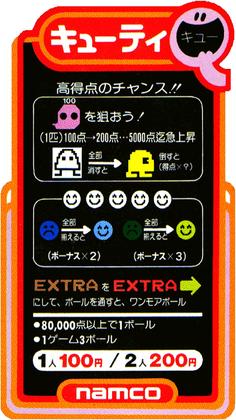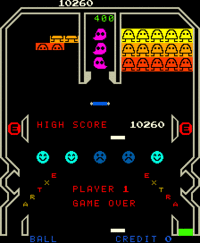Software:Cutie Q
| Cutie Q | |
|---|---|
 Japanese instruction card | |
| Developer(s) | Namco |
| Publisher(s) | Namco |
| Designer(s) | Shigeru Yokoyama Toru Iwatani |
| Series | Gee Bee |
| Platform(s) | Arcade, Mobile phone |
| Release | Arcade
|
| Genre(s) | Pinball, block breaker |
| Mode(s) | Single-player, multiplayer (alternating turns) |
| Arcade system | Namco Warp & Warp |
Lua error in Module:Lang/utilities at line 332: attempt to call field '_transl' (a nil value). is a 1979 block breaker/video pinball hybrid arcade game developed and published by Namco in Japan. The player controls a set of paddles with a rotary knob, the objective being to score as many points possible by deflecting a ball against blocks, ghosts, spinners and other objects on the playfield. It was designed by Shigeru Yokoyama, with spritework done by Toru Iwatani. It is the third and final game in the Gee Bee trilogy.
Cutie Q is described as Namco's first "character game", thanks to its use of colorful and cute character designs, a choice that would be a major influence on Iwatani's next project, Pac-Man. The title was derived from the band Creedence Clearwater Revival's 1968 cover of the song Susie Q, which Iwatani was a fan of. To lower manufacturing costs, it was only sold as a conversion kit for older Gee Bee and Bomb Bee arcade units.
The game was ported to the PlayStation in 1996 as part of the Japanese release of Namco Museum Vol. 2, with Bomb Bee included as an unlockable extra — international versions would instead replace them both with Super Pac-Man. The game was later included in 2007's Namco Museum Remix for the Wii, and later in its 2010 update Namco Museum Megamix. A Japanese mobile phone port was released for Yahoo! Keitai services in 2008, where it was renamed QTQ. Ports for both the Sharp X1 and PC-9801 were developed but later cancelled.
Gameplay
Cutie Q is a block breaker video game intermixed with elements found in pinball tables. The player controls a set of paddles using a rotary dial, the objective is to score as many points possible by deflecting a ball against objects on the playfield[1] - these include colorful "Rainbow Block" formations, pink ghosts known as "Minimon",[1][2] spinners that slow down the ball and small yellow creatures known as "Walkmen" that appear when an entire formation of blocks is destroyed.[1][2]
The middle of the screen has a set of sad-faced rollover symbols, and touching them with the ball will instead make them turn happy[2] — lighting all of them up increases the score multiplier.[1] An extra ball is awarded by touching each of the lettered symbols found on both sides of the screen, or by having the ball collide with the green drainage blocks found at the bottom.[2][1] Having the ball touch the bottom paddle will replace any cleared-out brick formations and increase the number of Minimon on the screen.[1]
Development and release
Cutie Q was developed and released by Namco in November 1979,[1] following the release of Galaxian.[3] The game was designed by Shigeru Yokoyama, known for his work on Galaga, while Toru Iwatani would design a number of the sprites.[3] It is the third game in the Gee Bee trilogy, and much like its predecessors was the result of a compromise with Namco, who was disinterested in creating pinball machines. It was described as Namco's first "character game" for its use of cute, colorful characters, a design choice that would have a major influence on Iwatani's next work, Pac-Man.[4][5] The name is derived from the band Creedence Clearwater Revival's cover of the song "Susie Q" from 1957, which Iwatani was a fan of.[4] To help save manufacturing costs, Cutie Q was only sold as a conversion kit for older Gee Bee and Bomb Bee arcade units.[1]
Cutie Q was ported to the PlayStation as part of the Japanese release of Namco Museum Vol. 2 in 1996, which also included its predecessor Bomb Bee as an unlockable extra.[6] Both titles would be replaced with Super Pac-Man in international releases. A limited edition "collector's box" was also released in Japan that bundled the game with a paddle controller and replica promotional material for the included games.[7] Cutie Q was also included in the 2007 compilation Namco Museum Remix for the Wii as one of the nine included arcade titles,[8] as well as its 2010 update Namco Museum Megamix.[9] A Japanese mobile phone port was released for Yahoo! Keitai network services on September 1, 2008, renamed to QTQ.[10]
In 1987, a port of Cutie Q and its predecessor Bomb Bee was being developed for the Sharp X1 by Dempa, a developer that had worked with Namco to bring many of the company's arcade titles to home computers in Japan.[11] Programming was done by Mikito Ishikawa, who was fascinated with the arcade version's source code.[11] The game was cancelled due to the impending rise of more powerful consoles, notably the Sega Mega Drive, with Dempa believing Ishikawa was proposing the port as a sort of joke.[11] A second port was in development by Ishikawa for the PC-9801 in the mid-1990s; a deal with Namco was nearly finished, but was cancelled again due to the company instead porting it to the PlayStation for Namco Museum Vol. 2.[11]
Reception and legacy
In their coverage of Namco Museum Vol. 2, Computer & Video Games called the game "brilliantly addictive" for combining the gameplay of Breakout and pinball tables, as well as for the inclusion of an "authentic" paddle controller to play it.[6] In a retrospective, Earl Green of Allgame noted of the game's importance to the creation of Pac-Man with its colorful character designs.[12] Kristan Reed of Eurogamer was more negative, calling the game "rubbish" in his review of Namco Museum Remix, commenting that while the game was interesting for its historical value, said that players would only play it for a few minutes before becoming bored.[13]
Nearly a decade after the release of Cutie Q, Namco would release a similar block breaker game in 1987, Quester, in an effort to compete against Taito's Arkanoid — Iwatani was assigned as the project's producer.[14] Although not directly related to the Gee Bee trilogy, the game's 26th stage is designed after a Rainbow Block Cutie Q.[15] This game was ported to the Japanese Wii Virtual Console in 2009, renamed to Namco Quester.[16]
Notes
References
- ↑ 1.0 1.1 1.2 1.3 1.4 1.5 1.6 1.7 Microcomputer BASIC Editorial Department (December 1986) (in Japanese). All About Namco. Dempa Shimbun. ISBN 978-4885541070.
- ↑ 2.0 2.1 2.2 2.3 Namco Museum Vol. 2 instruction booklet. Namco. 9 February 1996. pp. 12–13.
- ↑ 3.0 3.1 "Galaga - 30th Anniversary Developer Interview". Namco Bandai Games. 2011. http://shmuplations.com/galaga/.
- ↑ 4.0 4.1 Iwatani, Toru (2005). Introduction to Pac-Man's Game Science. Enterbrain. p. 33.
- ↑ Kohler, Chris (2005). Power-Up: How Japanese Video Games Gave the World an Extra Life. BradyGames. pp. 51–52. ISBN 0-7440-0424-1. https://books.google.com/books?id=auMTAQAAIAAJ. Retrieved July 16, 2019.
- ↑ 6.0 6.1 "Namco Museum 2". Computer & Video Games. June 1996. https://archive.org/details/Computer_and_Video_Games_Issue_175_1996-06_EMAP_Images_GB/page/n47.
- ↑ QBQ (2018) (in Japanese). プレイステーションクソゲー番付. Myway Publishing. p. 60. ISBN 9784865118346.
- ↑ Aaron, Sean (12 July 2009). "Namco Museum Remix Review (Wii)". http://www.nintendolife.com/reviews/2009/07/namco_museum_remix_wii.
- ↑ "Namco Museum Megamix Now Available for Wii". IGN. 16 November 2010. https://www.ign.com/articles/2010/11/16/namco-museum-megamix-now-available-for-wii.
- ↑ "バンダイナムコ、ソフトバンク端末向けアプリ「QTQ」「楽しいピンポン」配信" (in Japanese). ITmedia. 29 August 2008. https://www.itmedia.co.jp/mobile/articles/0808/29/news122.html.
- ↑ 11.0 11.1 11.2 11.3 Szczepaniak, John (11 August 2014). The Untold History of Japanese Game Developers (First ed.). SMG Szczepaniak. pp. 363. ISBN 978-0992926007. https://archive.org/details/TheUntoldHistoryOfJapaneseGameDevelopersVol.2JohnSzczepaniak/page/n361?q=cutie+q. Retrieved 12 August 2019.
- ↑ Green, Earl. "Cutie-Q - Review". http://www.allgame.com/game.php?id=9851&tab=review.
- ↑ Reed, Kristan (18 December 2008). "Namco Museum Remix". p. 2. https://www.eurogamer.net/articles/namco-museum-remix-review?page=2.
- ↑ Narusawa, Daisuke (1 March 1991). The Namco Book. JICC Publishing Bureau. ISBN 978-4-7966-0102-3.
- ↑ Yamakawa, Mari (November 1987). クエスター. Gamest. p. 88.
- ↑ Saeki, Kenji (20 August 2009). "バンダイナムコ、バーチャルコンソール アーケードに 「爆突機銃艇」、「メルヘンメイズ」など追加20本のタイトルを配信" (in Japanese). Impress Watch. https://game.watch.impress.co.jp/docs/news/309696.html.
External links
- Cutie Q at the Killer List of Videogames
ja:ジービー#キューティーQ
 |


